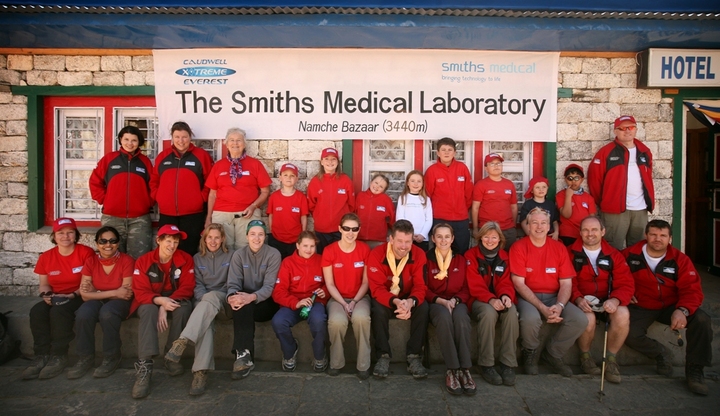Smiths Medical Young Everest Study (2007)
Nine healthy British children, aged 6 to 13, traveled to Mount Everest as part of our Caudwell Xtreme Everest expedition in 2007 to take part in a ground-breaking medical study that aimed to develop new treatments for critically ill children and those with both breathing and sleep problems. At the time Doctors did not yet fully understand children's responses to low oxygen levels, which are common in very sick children and can be fatal.
Named The Smiths Medical Young Everest Study (SMYES), they set out to investigate how the children would cope with low oxygen levels on the world's tallest mountain.
By investigating how healthy children's bodies cope and adapt at altitude, the SMYES team hoped to improve the chances of survival for very sick children. It also aimed to improve the quality of life of those with chronic/long term lung diseases and to develop new methods of detecting and treating children with disturbed sleep patterns.
The study was conducted by doctors and scientists from Great Ormond Street Hospital for Children (GOSH) and University College London's Institute of Child Health (ICH). It was supported by Smiths Medical, which is part of the global technology business Smiths Group and a specialist in respiratory care.
The Smiths Medical Young Everest Study was carried out in collaboration with Caudwell Xtreme Everest (CXE), the largest medical research project conducted at altitude. CXE is was conducted by UCL and investigated how adults acclimatise to low oxygen levels. It was supported by Sir John Caudwell, the entrepreneur and founder of The Caudwell Charity.
Professor Janet Stocks, Professor of Respiratory Physiology at UCL, who led SMYES, said at the time: The information gathered by the Smiths Medical Young Everest Study will provide important information about how children's bodies cope and adapt in conditions of low oxygen.
We hope that the results can be used to help the many children we treat at Great Ormond Street Hospital for Children who suffer from a shortage of oxygen due to a variety of lung problems and sleep disorders.
Professor Stocks added: Low oxygen levels are common in sick children: they are found in babies born too early or with heart abnormalities, children with chronic lung diseases such as cystic fibrosis and children so sick they need to be treated in intensive care units.
Because there have been so few studies on the effect of altitude on children, much of the advice to parents who travel to altitude with their children has to be based on adult data, even though it is recognised there may be important differences due to growth and development.
Professor Monty Mythen, the Smiths Medical Chair of Anaesthesia and Critical Care at UCL, spend three months in Nepal running the Smiths Medical High Altitude Laboratory at Namche Bazaar (3,400m/11,155ft) as part of CXE. His four children, Patrick, 13, Charlotte, 11, Alice, 8, and Tom, 6, at the time, took part in the Smiths Medical Young Everest Study.
Professor Mythen said: This is a tremendous education and opportunity for them. It?s a chance to experience travel and a different culture and the medical research could benefit many sick children in the future.
The other children involved in SMYES were: Harriet Themans, 11, her brother Giles, 9, and her sister Katrina, 7, William Ogden, 10, and Mayank Naik, 6.
The children were also accompanied by Professor Janet Stocks, Dr Samatha Sonnappa and physiologists Emma Scrase, Aidan Laverty and Johanna Dingle-Gavlak.
The children arrived in Kathmandu on March 25. They then flew to Lukla and treked from there to the Smiths Medical High Altitude Laboratory at Namche Bazaar before trekking on to Tengboche (3,870m). The older children then continue to Everest Base Camp (5,300m). All of the children returned to the UK on April 15.
Each morning the children had to record how they were feeling in a diary. They were also given a breathing test and had their blood pressure, oxygen saturation and heart rate measured. Doctors then monitored their sleeping patterns wherever possible to see how well they were adapting to altitude.
Srini Seshadri, Group Managing Director of Smiths Medical, said of the study: Smiths Medical has enjoyed a long-standing relationship with Great Ormond Street Hospital and we are delighted to be supporting this exciting research project.
This research is important because respiratory and health problems are a huge burden during childhood and also because an increasing number of families are taking young children on foreign holidays which include exposure to the type of altitude that will be experienced during this trek.
Doctors involved in CXE concluded they would not be able to apply the results of the adult study to children because children's bodies work differently: they are not simply "miniature adults". They decided to take advantage of the unique infrastructure provided by the study to carry out similar tests on children.





